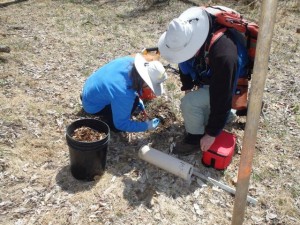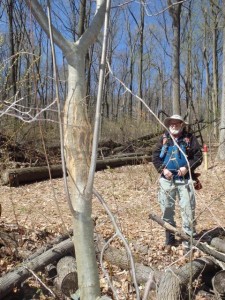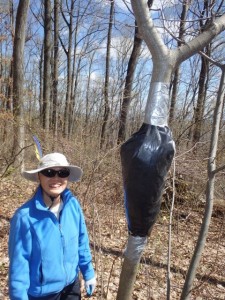Mariton: American Chestnuts 2015
by Tim Burris, Preserve Manager
American Chestnuts (Castanea dentata) got another boost at Mariton last week. Volunteers Mike and Kieu Manes are dedicated chestnut enthusiasts who do a ton of work to reestablish the American Chestnut in our region. I feel particularly honored that they appreciate our work at Natural Lands Trust, and have focused efforts on a few of our preserves, including Mariton.
Just to recap, the American Chestnut was the dominant tree in many of the forests in the eastern United States until it was brought to the brink of extinction by blight in the early 1900’s. A fungus Cryphonectria parasitica, was introduced with nursery stock from Asia, where many Castanea species are adapted to the blight. Pre-blight, American Chestnuts were the backbone of many economies, especially in the southern Appalachian’s where the nuts were collected to feed both humans and livestock. The wood was ideal for railroad ties, utility poles, barn siding and even furniture. Besides its human uses, it was important to wildlife as the nuts fueled passenger pigeons, bears, deer, turkeys, squirrels, woodpeckers, etc. The flowers attracted lots of native pollinators, which in turn attracted birds. This species’ dominance in our forests is probably the result of Native American horticulture, which promoted the growth of certain useful species like chestnuts. The American Chestnut Foundation is dedicated to returning this species to our forests through a variety of experimental techniques.
One of our projects last week was an experimental bandage on an American chestnut in Mariton’s forest. This tree may have re-sprouted from the roots of a tree affected by the blight over a hundred years ago. It was doing pretty good, but we noticed signs of blight on the trunk last year. Mike and Kieu researched an experimental technique to pack soil around the scarred area, which is then wrapped in plastic. The idea is that microbes in the soil can battle the infection from the fungus and allow the tree to heal itself. When we got together to apply the bandage, we realized that the blight had done more damage to the tree than we could see from the trail. We may not be able to save this tree, but it is worth a try. Fortunately, there are two more shoots on the same root that look healthy and that we will continue to monitor.
We then planted about two dozen seeds. Mike and Kieu spend many fall days collecting chestnut seeds (with permission) to send to State College for germination. They keep a small percentage of what they collect to germinate and replant in the spring. They collected nearly 100 nuts from Mariton’s trees (that were planted by Mariton’s founders, the Guerrero’s). We planted several of these germinated seeds, as well as some 15/16ths highbreds. We replaced the few seeds that didn’t survive last year’s planting, and expanded planting into new areas.
The Chestnut is an American classic, and I am really grateful for all of the Manes’ work in helping to re-establish this species in Mariton’s forest.



